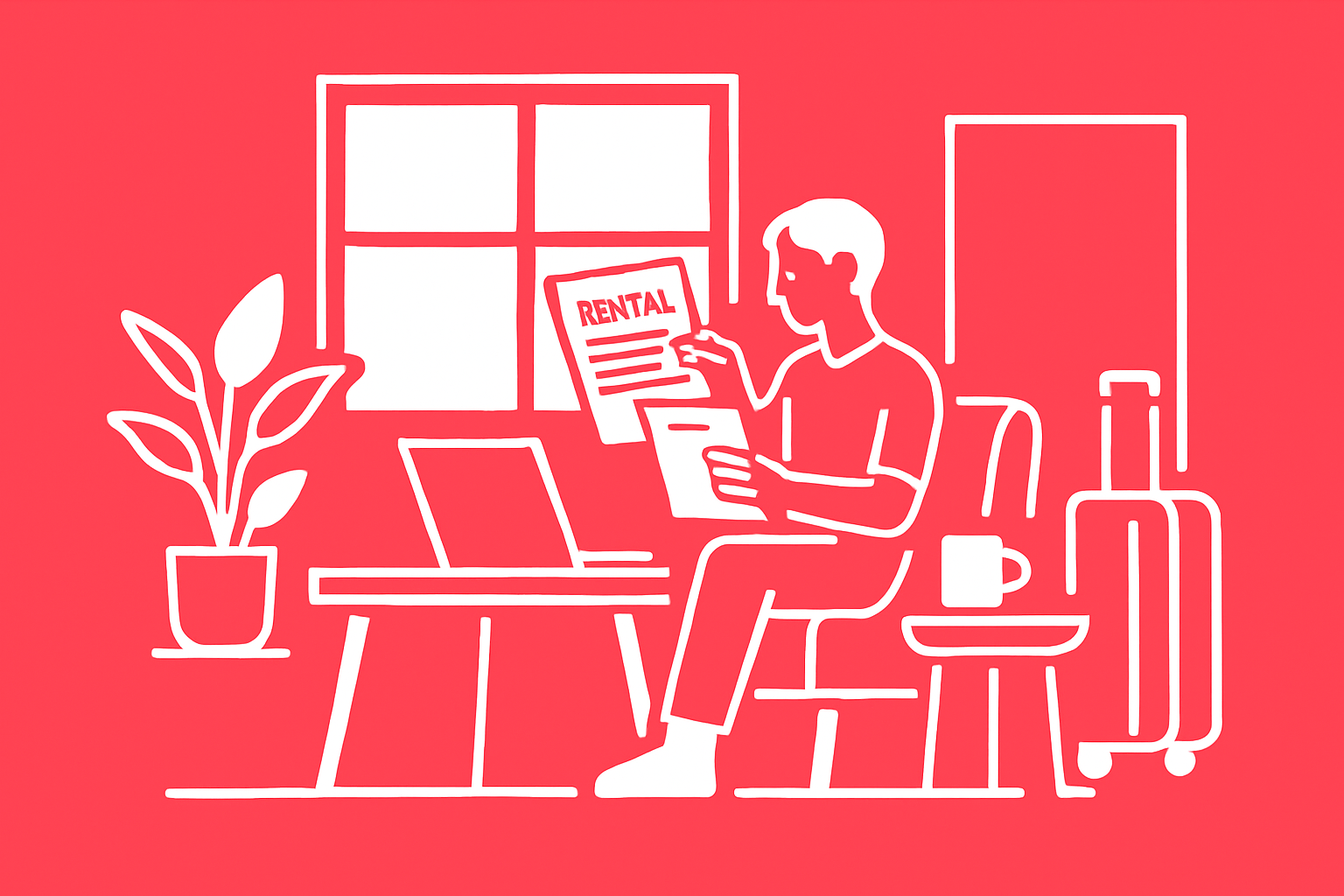|
Getting your Trinity Audio player ready...
|
Picture this: You’re searching for a new place to live, but the world of rentals feels overwhelming. Prices are climbing, listings can be misleading, and finding a space that feels like home for more than just a few months is harder than ever.
This guide is here to make sense of long term apartment rentals as we move into 2025. Whether you’re a professional, a family, or an expat, you’ll find clear strategies, up-to-date insights, and practical steps to help you secure a home you love.
We’ll break down the latest market trends, how to prepare for a lease, tips to find the right apartment, negotiation tactics, and ways to make your rental experience even better. Ready to take the guesswork out of renting? Let’s get started with everything you need to know for a smarter, smoother search.
Understanding the 2025 Long Term Apartment Rental Market
The landscape of long term apartment rentals in 2025 is rapidly shifting, shaped by new lifestyles, economic factors, and evolving renter priorities. Whether you're a professional, a family, or a digital nomad, understanding the latest trends and data can give you a powerful edge in finding your next home.

Evolving Rental Trends
The world of long term apartment rentals is embracing flexibility more than ever. With remote work and digital nomadism on the rise, renters are seeking leases that offer extended stays and adaptability. In 2024, surveys found that 62% of renters now prefer leases longer than six months, reflecting a clear desire for stability.
Demand for furnished, move-in-ready units is also climbing, especially in major cities like Stockholm and Berlin. These cities are adapting by offering more options tailored to long term apartment rentals, catering to those who prioritize convenience and flexibility.
Key Market Drivers and Challenges
Several forces are influencing the long term apartment rentals market in 2025. Inflation and persistent housing shortages are pushing rental prices higher in many regions. At the same time, new regulations are rolling out stronger tenant protections and increased landlord obligations, aiming to create fairer rental experiences.
Sustainability has also become a significant differentiator. Eco-friendly housing features are attracting attention, while competition for high-quality units remains fierce. Navigating these drivers is key to success in today’s rental landscape.
Regional Differences and Hotspots
The long term apartment rentals market varies greatly by region. In Europe, cities like Lisbon and Warsaw are seeing rapid growth in long-term supply, while North America’s hotspots include Austin and Toronto. Asian cities such as Singapore and Seoul are also expanding their inventory for extended stays.
Local laws can impact lease length and tenant rights. For instance, Europe often favors tenant protections and longer minimum lease terms, while North America tends to offer more flexibility. Understanding these regional nuances helps renters make informed choices.
Who Benefits Most from Long Term Rentals?
Long term apartment rentals are especially advantageous for professionals on assignment, families relocating, students, and digital nomads. Companies often secure extended rentals for project teams, offering employees a cost-effective alternative to hotels.
The benefits are clear: more space, home comforts, and greater stability. For many, long term apartment rentals provide a sense of belonging and routine, making them a smart choice over short hotel stays.
Data-Driven Insights for 2025
Rental rates and occupancy trends are central to understanding long term apartment rentals this year. According to the 2025 Apartment Housing Outlook, average rates continue to rise, with furnished units commanding higher premiums. Vacancy rates remain low in most urban centers, signaling strong demand and limited supply.
Recent reports by JLL, Statista, and CBRE indicate that sustainability and flexible lease terms are shaping the future. Monitoring these metrics can help renters spot opportunities and avoid overpriced listings.
Common Misconceptions
Many believe long term apartment rentals are only for expats or corporate travelers, but that’s no longer the case. Flexible contracts and diverse lease options are attracting local renters, students, and families alike.
It’s also important to distinguish between lease terms and short-term stays. As flexible agreements become more common, the market is shifting to accommodate a wider range of needs, dispelling old myths about who can benefit from long term apartment rentals.
Steps to Secure a Long Term Apartment Rental
Finding the best long term apartment rentals in 2025 means more than just browsing listings. With competition high and the market evolving rapidly, a strategic approach can make all the difference. Follow these essential steps to streamline your search, avoid common pitfalls, and secure a home that truly fits your lifestyle.

Step 1: Define Your Needs and Budget
Start by outlining your non-negotiables for long term apartment rentals. Think about:
- Preferred location and neighborhood vibe
- Apartment size and number of bedrooms
- Essential amenities (laundry, parking, elevator)
- Commute time to work or school
Next, set a realistic budget. Factor in not only rent, but also utilities, internet, insurance, and potential maintenance fees. Using a simple spreadsheet or budgeting app will help you track all monthly expenses and avoid surprises. This clarity ensures you stay within financial limits while focusing on apartments that truly meet your needs.
Step 2: Research Rental Platforms and Agencies
Explore reputable platforms specializing in long term apartment rentals. Popular choices include Zillow, Idealista, and trusted local agencies. Always be vigilant for red flags like outdated listings, hidden fees, or requests for upfront payments before viewings.
Check reviews and ratings for both platforms and property managers. Due diligence at this stage prevents wasted time and potential scams. For deeper insights into market dynamics and platform trends, consider resources like the 2025 U.S. Rental Market Trends & Conditions, which spotlight evolving tenant needs and digital innovations.
Step 3: Shortlist and Compare Properties
After gathering options, create a comparison matrix for your shortlisted long term apartment rentals. Evaluate each property by:
| Criteria | Property A | Property B | Property C |
|---|---|---|---|
| Price | |||
| Lease Terms | |||
| Amenities | |||
| Furnished/Unfurnished | |||
| Commute Time |
Take advantage of virtual tours and remote viewings if available. Weigh the pros and cons of furnished versus unfurnished units, keeping in mind your moving plans and length of stay. This methodical approach helps you avoid emotional decisions and focus on long-term comfort.
Step 4: Prepare Documentation and References
Most landlords require a standard set of documents for long term apartment rentals:
- Proof of income (pay stubs, contracts)
- Valid government ID or passport
- Recent credit report
- Rental history or landlord references
International renters may need translated or notarized documents, and sometimes a guarantor. Prepare a digital application packet to streamline your process—having everything ready upfront puts you ahead of other applicants and shows you’re serious.
Step 5: Schedule Viewings and Ask the Right Questions
Arrange in-person or virtual viewings for your top long term apartment rentals. During each visit, ask questions like:
- Who is responsible for maintenance and repairs?
- What utilities are included in the rent?
- Are there any recent renovations or known issues?
Bring a checklist to spot hidden problems such as mold, noise, or neighborhood safety concerns. Take photos and notes during each visit to make comparisons easier later. This diligence helps you avoid unpleasant surprises after move-in.
Step 6: Negotiate Lease Terms
Before signing, review the lease agreement closely. Look for key clauses related to:
- Renewal options and break clauses
- Rent increase caps and notice periods
- Subletting and guest policies
Negotiation is common in long term apartment rentals. Don’t hesitate to request concessions like a lower deposit, minor upgrades, or included amenities. For example, some tenants have successfully negotiated for in-unit appliances or flexible move-in dates. Clear, respectful communication is the key to favorable terms.
Step 7: Finalize the Agreement and Move In
Once terms are agreed, review the lease line by line before signing. Understand local laws on security deposits, including maximum amounts and clear return policies.
Conduct a detailed move-in inspection, documenting the property’s condition with photos and a signed checklist. Set up essential utilities and services immediately. These final steps ensure your long term apartment rentals experience starts on the right foot, minimizing disputes and maximizing comfort from day one.
Essential Features and Amenities for Long Term Rentals
Finding the right features and amenities can make or break your experience with long term apartment rentals. Today’s renters expect more than just four walls—comfort, convenience, and flexibility now define a truly “long term friendly” home. Let’s explore the essentials for modern renters in 2025.

What Makes a Rental “Long Term Friendly”?
Long term apartment rentals stand out when they offer spacious layouts, clever storage solutions, and flexible workspaces. With remote work now mainstream, high-speed internet and tech-ready infrastructure are must-haves. Floor plans that maximize natural light and accommodate both living and working needs are highly sought after. According to Navigating the 2025 Rental Market: 7 Key Predictions, property managers are prioritizing these features to adapt to evolving renter demands. Comparing modern layouts, you’ll notice a focus on comfort and adaptability—key ingredients for a lasting stay.
Importance of Furnished vs. Unfurnished Rentals
Choosing between furnished and unfurnished long term apartment rentals depends on your lifestyle. Furnished units are ideal for expats, professionals, or anyone seeking a seamless move. They save time and money on moving, but come with an average 18% rent premium (2024 survey). Unfurnished rentals, on the other hand, offer flexibility and lower monthly costs, perfect for families or those settling in for several years. Consider your stay duration and budget before deciding. A quick cost analysis can help weigh furniture expenses against higher rent.
Community and Lifestyle Amenities
Modern long term apartment rentals often provide more than just private space. On-site gyms, coworking areas, and lush outdoor zones are becoming standard. Social events and networking opportunities help renters build connections, especially in new cities. Many new complexes feature community lounges and shared kitchens. Resident testimonials frequently highlight the value of these amenities, noting how they foster a sense of belonging and make everyday life more enjoyable. When comparing options, look for vibrant communities that match your lifestyle.
Sustainability and Eco-Friendly Features
Sustainability is no longer a bonus—it’s a priority for many seeking long term apartment rentals. Features like energy-efficient appliances, green building certifications, and robust recycling programs are now common in top-tier properties. Statista reports that 41% of renters actively seek out eco-friendly options. Green living not only benefits the planet but can also lower your utility bills over time. As the market evolves, expect more landlords to showcase sustainable upgrades as a core selling point.
Safety, Security, and Support Services
Safety and support are foundational for comfortable long term apartment rentals. Look for buildings with 24/7 security, smart locks, and well-lit common areas. Emergency maintenance services ensure quick response to unexpected issues. Many premium properties offer concierge and housekeeping packages, adding convenience for busy professionals or families. Comparing support services across providers can reveal significant differences. Peace of mind often comes from choosing a rental that prioritizes both safety and responsive management.
Accessibility and Inclusivity
Accessibility is essential to make long term apartment rentals work for everyone. Wheelchair access, pet-friendly policies, and family-oriented layouts are increasingly standard. Some properties go further, adapting spaces for diverse needs and promoting true inclusivity. For example, inclusive housing projects may feature adjustable counters or quiet zones for remote work. Whether you’re a digital nomad, relocating family, or someone with specific requirements, today’s market offers more options than ever—ensuring everyone can find a place to call home.
Navigating Lease Agreements and Tenant Rights
Navigating lease agreements is a critical step for anyone considering long term apartment rentals. Understanding the fine print can make the difference between a hassle-free experience and unexpected headaches. Each clause, from renewal options to early termination, shapes your daily life and financial commitments. Let’s break down what you need to know to protect yourself and get the most out of your rental.

Understanding Your Lease
When you enter into long term apartment rentals, you’ll encounter two main lease types: fixed-term and month-to-month agreements. Fixed-term leases offer stability, locking in terms and rent for a set period, while month-to-month options provide flexibility if your plans may change.
It’s essential to review key legal terms like subletting, early termination, and renewal clauses. Always read your lease in full and ask for clarification if anything is unclear. Annotated sample leases can help you identify what’s standard versus what might be unfavorable. Remember, leases can vary widely, so knowing what’s typical for long term apartment rentals in your region is crucial.
Tenant Rights and Responsibilities
Every renter in long term apartment rentals should know their rights and obligations. Local regulations often dictate notice periods, deposit protections, and eviction rules. For example, in California, there are updated protections and requirements for 2025—see the California Tenant Rights Guide 2025 for specifics on legal protections and lease essentials.
Tenants are typically responsible for everyday maintenance, adhering to noise policies, and following subletting guidelines. Comparing EU and US tenant rights reveals differences in notice and eviction processes. Understanding these rules helps you avoid disputes and stay compliant throughout your long term apartment rentals journey.
Landlord Obligations and Support
Landlords in long term apartment rentals have legal duties that protect tenants. These include maintaining a safe property, addressing repairs promptly, and meeting local safety standards.
If you encounter issues, start by submitting a written request. If problems persist, follow an escalation process that may involve local tenant boards. Clear communication with your landlord is key. Knowing your rights ensures you receive the support you deserve during your long term apartment rentals experience.
Protecting Your Interests
To safeguard your interests in long term apartment rentals, consider renters insurance. It typically covers personal belongings, liability, and sometimes even relocation costs. Average premiums vary by region but are usually affordable.
Be diligent with your security deposit. Document the property’s condition at move-in with photos and a checklist. When moving out, follow a checklist to maximize your chances of a full deposit return. These simple steps protect your finances and peace of mind throughout your stay.
Avoiding Common Pitfalls
Watch out for overlooked clauses, hidden fees, or unclear responsibilities in your lease. Some renters have faced costly mistakes, such as not clarifying pet policies or accepting illegal fees. Always review every part of your agreement and ask questions.
Here’s a quick checklist to avoid pitfalls:
- Confirm all fees and deposit terms.
- Clarify maintenance responsibilities.
- Ensure all verbal promises are in writing.
Staying vigilant helps you avoid common setbacks in long term apartment rentals.
Resources for Legal Support
If you need help during your long term apartment rentals journey, there are several resources available. Tenant unions, local legal aid organizations, and online forums offer advice and support.
If a dispute escalates or you’re unsure about your rights, don’t hesitate to seek professional legal advice. Being proactive with support resources ensures you’re never navigating challenges alone in your long term apartment rentals.
Optimizing Your Long Term Rental Experience
Settling into long term apartment rentals can feel overwhelming at first, but a few smart strategies will help you make the most of your new home. Whether you’re a professional, family, or digital nomad, optimizing your rental experience is about more than just signing a lease. It’s about building connections, personalizing your space, and using the right tools to simplify daily life.
Building a Positive Landlord-Tenant Relationship
A strong landlord-tenant relationship is the foundation of a smooth stay in long term apartment rentals. Open communication sets the right expectations and helps avoid misunderstandings. Schedule regular check-ins with your landlord, even if just by email.
Quick reporting of maintenance issues leads to faster resolutions and less stress. Many tenants find that showing respect for the property and prompt rent payments helps foster goodwill.
Positive relationships often result in landlords being more flexible with lease extensions or upgrades. Small gestures, like a thank-you note after repairs, can go a long way.
Personalizing and Maintaining Your Space
Making your apartment feel like home matters, especially for long term apartment rentals. Start by adding personal touches—think framed photos, cozy throws, or a favorite plant. These small changes can transform even the most generic space.
Stay on top of cleaning and minor repairs to avoid disputes. Create a maintenance checklist for monthly tasks. For a budget-friendly touch, consider peel-and-stick decor or rearranging furniture to better suit your lifestyle.
A well-maintained home not only boosts your comfort, but also protects your security deposit at the end of your lease.
Managing Finances and Utilities
Keeping finances organized is crucial for a stress-free rental experience. Track your rent, bills, and other expenses using a spreadsheet or finance app. Set up reminders for due dates to avoid late fees.
When possible, shop around for better utility providers to save on costs. Some long term apartment rentals include certain utilities, so clarify what’s covered in your lease.
Below is a simple table to help you track monthly expenses:
| Item | Amount | Due Date |
|---|---|---|
| Rent | $ | |
| Electricity | $ | |
| Internet | $ | |
| Insurance | $ |
Dealing with Relocation and Lease Extensions
Life can be unpredictable, especially for those in long term apartment rentals. Planning ahead for potential job changes or family needs is essential. Begin discussions about lease extensions or terminations at least two months before your contract ends.
Create a timeline for relocation, including tasks like notifying your landlord, scheduling movers, and updating your address. This approach minimizes last-minute stress and ensures a smooth transition.
If you’re considering extending your lease, negotiate terms early to lock in favorable rates or added amenities.
Community Engagement and Local Integration
Getting involved in your new community turns an apartment into a real home. Attend neighborhood events, join local groups, or participate in resident meetups. Many complexes offer social activities that make it easy to meet new people.
Building a support network can help you settle in faster and enjoy your long term apartment rentals more fully. Expat programs or local welcome committees are great resources for newcomers.
Digital Tools and Apps for Renters
The right digital tools can make managing long term apartment rentals effortless. Use apps like RentCafe for rent payments, maintenance requests, and communication with property managers.
Virtual community platforms keep you connected with neighbors and informed about building updates. Maintenance tracking apps help you log issues and request repairs quickly.
Tech-enabled communities often feature digital notice boards and online booking for amenities, streamlining your everyday life.
Now that you’ve got a clear picture of what it takes to find the right long-term apartment—whether it’s budgeting, comparing amenities, or navigating lease agreements—you’re already ahead of the rental game. If you’re ready to turn all this know-how into action, why not take the next step and check out real options designed for comfort, productivity, and peace of mind? You deserve a place that feels like home, supports your lifestyle, and helps you focus on what matters most. Let’s make your next move a smooth one—See Available Homes.


